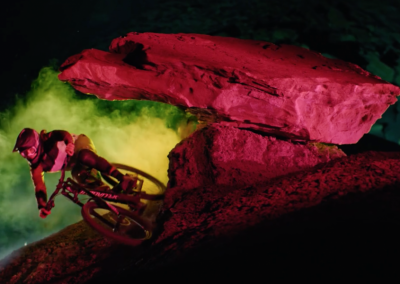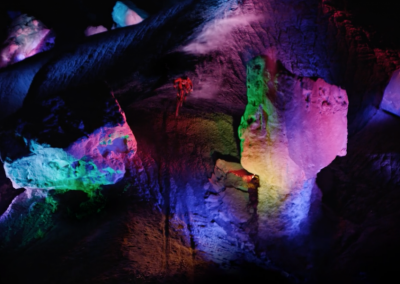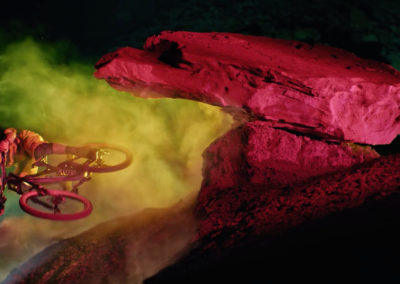There are many variations of extreme sports, and they fascinate fans all over the globe. However, there’s another facet to this industry and that’s the individuals that actually film these athletes in some of the most inhospitable environments.
Such is the case for Darklight, a film by director Mike Brown and producer Zac Ramras of Sweetgrass Productions; in their quest to film professional mountain biking they traveled to the most remote Ewok forests of Oregon and the moonscapes of Utah. “These projects are just logistical nightmares; there’s always so much that can go wrong. And things will go wrong and you just have to be ready for them and make the best of every day. Consequently, you just can’t bring any light out there, you just can’t bring any equipment out there because it’s just not going to work,” explains Lighting Designer and Gaffer Mark Stuen.
To make sure their vision was captured correctly on film, Stuen chose the RC4Magic-900 wireless system to accompany them on their filmic quest. “The build quality, the stability and the reliability is unsurpassed; they are the best,” says Stuen.
The production took the team into the deserts of Utah and into the deepest forests of Oregon; typically they would off-road for about an hour to their chosen locations. “We were shooting in desert and we were shooting in the forest. During the day were well over 100 degrees, but we were shooting at night for most of it so it was a little better then, but still about 87 degrees. All of our gear had to be prepped and ready to work in this environment- the dirt in Oregon and the sand in Utah; there was always a risk of flash floods,” the lighting designer explains.
Once the production arrived at a location, they would call on a team of trail builders to create a series of ramps for jumps that were integrated into the natural landscape. Stuen says, “The night before, we would talk to the riders and find out how they’re feeling; each area had a different intensity to it, so if they were feeling a little tired, you didn’t want to have them doing massive jumps or doing backflips or things like that. Then, that next morning, the builders would go out for the day, and get that site ready. We would roll in about three hours before sunset and start moving gear into that location and roughing in where our lighting plan would be. Once it was dark, we could start turning pieces on. Then we would fine tune and shoot all night.”
The trail runs themselves were long, and that’s where RC4 came into the picture. “For this project, using RC4 was the only way to go. Anything less wasn’t going to operate over the distances that we were talking about. Inexpensive wireless starts to get funky around 100’, while the midrange stuff is good between 100’ to 600’,” notes Stuen.
For Darklight, Stuen chose the RC4Magic-900 as the backbone of the wireless rig. “We’d put the RC4Magic-900 DMXio Transceivers in the middle of a run– with just an onboard antenna, that gave us about 800’ to 1000’ in both directions. Then somewhere along that 800’ in both directions, we would put another little tower that had an RC4 RC4M-900 DMX4dim 4-Channel Wireless Dimmer. Then we would have lower grade transceivers, and those would go to the lights that were around them. RC4 had to be our backbone because of the distance,” the lighting designer states.
The RC4Magic-900 is one of the firm’s newer products in the RC4 product family. “RC4Magic wireless DMX and dimming systems have always provided every user and project with unique digital IDs that belong only to them. RC4Magic-900 builds on this with additional data security enhancements, including optional AES encryption. RC4Magic-900 dimmers provide super-smooth LED dimming, RC4 Digital Persistence to emulate the thermal decay of incandescent lamps, the RC4 Flkr Engine for fire, welding spark, and other effects, ColorMatch to optimize color rendering of LEDs, HSL for hue/saturation/level control, servo motor positioning, and much more,” explains James D. Smith, President and Chief Product Developer at RC4 Wireless.
The battery-operated RC4Magic-900 runs in the 902-928 MHz RF band with certification for use in Canada, USA, Australia, Brazil, and Singapore. Smith adds, “Just like 2.4GHz, 902-928MHz is an ISM band, which stands for Industrial/Scientific/Medical. ISM bands do not require end-users to obtain radio operator licenses. The internationally harmonized 2.4GHz and 5.8GHz bands get more and more crowded every year because corporate investment in new designs in those bands results in products that can be sold worldwide; designing a product that works only in limited markets isn’t popular in corporate boardrooms. But the FCC in the United States allows higher RF power at 900MHz than they allow at 2.4GHz, which increases range. Lower frequencies propagate better – they travel further and pass through objects for effectively. All of this combined is why RC4Magic-900 delivers about four times the range of RC4Magic Series 3 at 2.4GHz. And, by the very nature of how 900MHz works, we’re beating all the other 2.4GHz wireless DMX products, too.”
Superior signal propagation was critical for Sweetgrass. “Compared to the other wireless equipment we had on site, the RC4 equipment had no problem with line of sight. When we were in the trees in Oregon, it didn’t matter if we were line of sight or not. You could hike 1200 feet through the bushes and you’d still have signal with the RC4 equipment. With the inexpensive gear, you’d go around a couple trees and you’d have absolutely nothing at all,” he notes.
Another benefit of the RC4Magic-900 was the complete lack of stutter. Stuen says, “With other wireless systems, if you’re continuously changing a light, you’ll have stutter. After that initial connection, you’d hope that there was no more stutter, smooth fades and better transitions.” However that wasn’t the case with the other equipment on site and the stutter persisted, which brought on another issue. If we’re dealing with turning on and off lights as riders are flying around, that timing is very precise; we can’t have stutter for safety reasons. If we didn’t have a stable product, it physically could have put the riders at risk.”
Stutter also would cause problems with the physical aspects of filming. Stuen says, “We were shooting really slow motion and now all of a sudden, an 1/8 of a second or a ¼ second delay is the whole shot. It’s so much more pronounced.” These problems were eliminated by using RC4Magic-900 as the backbone of the wireless system.
Stuen and the team at Sweetgrass considered various different ways to utilize RC4 systems for Darklight. “We were going to run many multi universes of RC4 wireless for pixel control of the LEDs that we were going to put on the riders clothes,” the lighting designer explains. Technologically, the RC4 gear was a perfect fit for the concept. However, in practice, there were aesthetic issues involved. “It was interesting to look at but it wasn’t what we wanted. It was looking comical instead of wow.”
RC4 was the right choice for Darklight from the very beginning. Stuen confides, “RC4 has a very interactive and hands on support and tech department, which helped me even before I bought anything. They helped me troubleshoot and test some of my conditions and hypotheses. That’s obviously worth real production money and real money to me because it allows me to come informed when it’s time to actually purchase equipment to take out into the middle of nowhere. That kind of support system is very important for what I do.”
Darklight premiered online on Tuesday, October, 21 2015; Sweetgrass has more films in the works as well. Sean Dane, Sales Director and Application Specialist at RC4 Wireless concludes, “Our motto at RC4 Wireless is ’Live Life Untethered.’ The team at Sweetgrass Productions exemplifies what that means in all that they do. We’re thrilled to be part of it now and we look forward to the challenges they’ll bring next, as they push the boundaries of wireless lighting with their unique flavor of exhilarating and eye-catching films.









